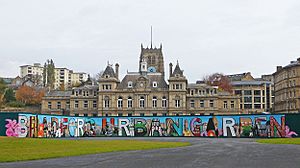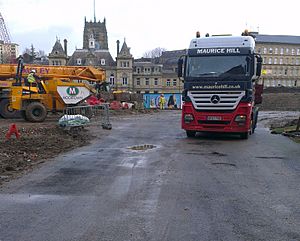Forster Square facts for kids
Forster Square was a well-known place in central Bradford. It was changed a lot, or "demolished," during the Broadway building project in 2006. Its name is still used for the Forster Square railway station, a shopping area, and a road in front of Kala Sangam.
Contents
History of Forster Square
Forster Square was created in the late 1800s. It was named after William Edward Forster, an important politician from that time. He was a Member of Parliament (MP) for Bradford for a long time. He also served as the Education minister in a government led by Prime Minister Gladstone.
Until 1958, Forster Square was a large, open space. It was shaped like a triangle and had public gardens. A statue of William Edward Forster stood in the middle. It was also a very busy place where many buses and trams stopped.
The original Forster Square railway station was partly in front of the square from 1924 until 1990. The current station, which has the same name, opened about 300 meters (980 feet) north of the old one. The old station building was then pulled down.
Changes in the 1950s and 1960s
In the 1950s and 1960s, much of central Bradford was rebuilt. This was part of a plan designed by Stanley Wardley. A new main road called Petergate was built. This road connected a newly designed Forster Square to Leeds Road.
Part of the gardens in the square became a walled area in the middle of a busy traffic roundabout. People could only reach it by walking through underground tunnels. Two large buildings, Central House and Forster House, were built on the west side. Forster House was designed by John Poulson. The only building that remained after this rebuilding, besides the railway station, was St Peter's House. This building used to be the main post office.
The Broadway Project
On March 18, 2004, work began to clear the Forster Square site. This was for the new Broadway shopping center project. Forster House was pulled down to make space for the new development. A new road, Lower Kirkgate, was also built. This road connected the junction of Kirkgate and Cheapside with the junction of Canal Road and Bolton Road. Since then, you can no longer drive straight through from the north (Canal Road or Manor Row) to Leeds Road.
By late 2006, the site was empty and flat. There was only a large pile of rubble in one area. For the first time in many years, St Peter's House and Bradford Cathedral behind it could be seen clearly from the city center. The Broadway project was expected to be finished in 2007. However, the developers, Westfield, said that construction would not start until they found stores to rent space there.
Discoveries by Archaeologists
After the demolition, archaeologists had a chance to dig up the area. They explored the land between Forster Square and Cheapside. They found signs of buildings that were most likely from the 1500s. They also found smaller items like old coins, pottery, and clay tobacco pipes. A bone spoon and a bone toothbrush were also discovered.
Andrea Burgess, a senior archaeologist, shared her excitement. She said:
These are the first real digs in the center of Bradford. We have historical records about the streets in the 1600s and 1700s. But we have never found the actual remains of the people who lived here. Some of the work is still very new. But it seems the oldest finds are from the 1600s. We have found parts of buildings. There are also hints of industrial work happening near the beck (a small stream). This was a good water source for factories. This is the earliest archaeological evidence we have from Bradford. So, when we get the final results, it will be very exciting.
She also hoped the findings would tell more about life in Bradford during the English Civil War. She explained:
Bradford played a big part in the Civil War. There are amazing old drawings of the parish church right next to the site. They show woolsacks hanging from the top of the tower. This was to protect it during attacks. There are written stories of soldiers coming into Bradford and crossing the beck. We know they hid in houses that were around the beck at that time. It is not confirmed yet. But some of the remains found could be from the Civil War period. This will give us an idea of what people were writing about. Archaeologists will keep watching the Forster Square redevelopment as work continues. This way, they can save and record any other information that appears. Otherwise, it depends on where the building work is happening if we suggest more archaeological work.



